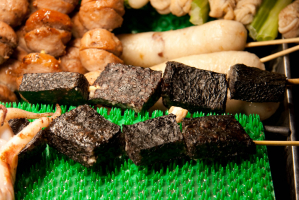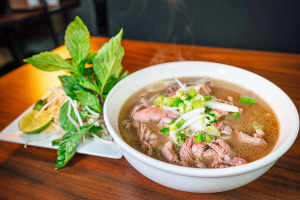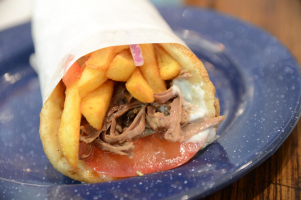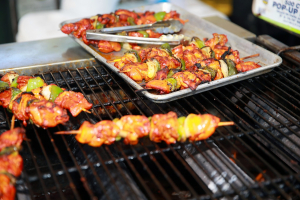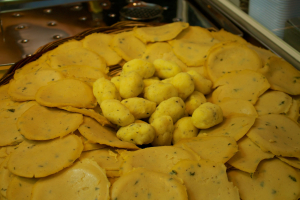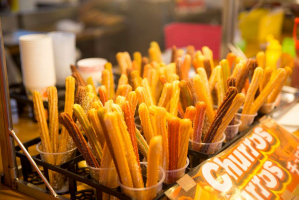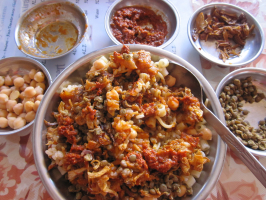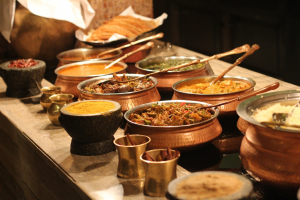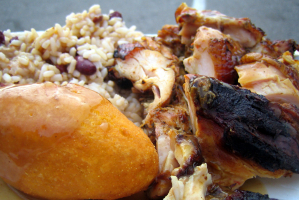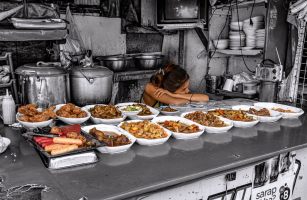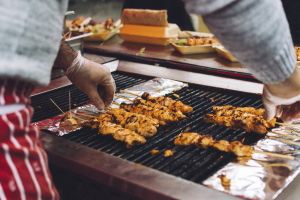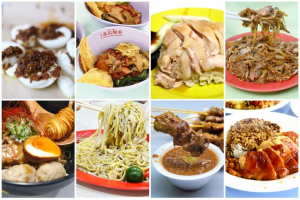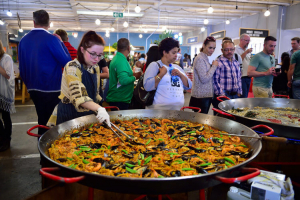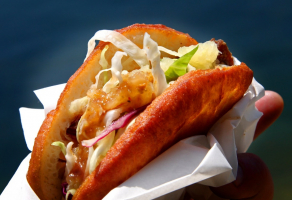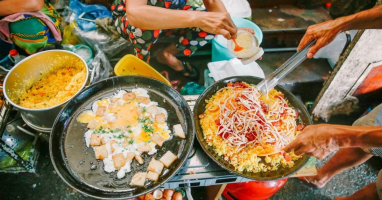Top 10 Most Popular Japanese Street Foods
To fully enjoy Japanese cuisine, you should look for street food. These dishes are not only delicious and beautiful but also reasonably priced. There are ... read more...countless street foods that you should try when coming to Japan, so Toplist has compiled a list of the most popular Japanese street foods.
-
Yakitori comes from the land of the rising sun and it is one of the most popular Japanese street foods. Yakitori in Japanese means grilled chicken skewers. That is, the Japanese use chicken to skewer on a stick and grill it on a charcoal stove. Nowadays, Yakitori is also used to refer to all skewered dishes in general. Currently, in Japan, Yakitori is often sold in restaurants or stalls on many streets.
Yakitori has a blend of salty and sweet flavors, with a hint of sesame oil and ginger, demonstrating the characteristics of this country's cuisine. This grilled chicken dish is also quite simple and easy to make. You can choose any part of the chicken to cook. Depending on your preferences, you can use additional vegetables and beef to grill together. What makes the dish special is the use of a typical sauce called "tare". Yakitori sauce is made from soy sauce, Mirin, Sake, and sugar in a certain ratio to create a balance between saltiness and sweetness.
Nowadays, Yakitori is enjoyed by a large number of people not only in Japan but also in other nations. This dish comes with a stunning dipping sauce and keeps the natural sweetness of the grilled meat and vegetables. Enjoying Yakitori, you will feel the culinary and cultural characteristics of the land of cherry blossoms. This dish is especially suitable for weekend meals or gatherings with friends and relatives.
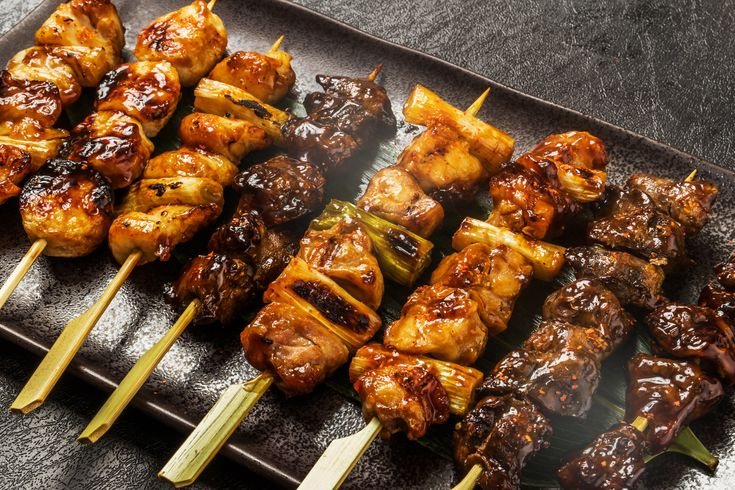
Screenshot of https://www.pinterest.com/pin/97882991894218481/ Video by Taste The World -
Takoyaki is a spherical snack made of flour and filled with octopus, baked in a takoyakiki pan. The main ingredient of the filling is minced or diced octopus (or completely filled with cheese), Takoyaki can be filled with other things and sprinkled with some spices as well as soaked with sauce depending on the recipe which may be different.
Takoyaki is a dish that has been around since 1953 and is a symbol of the Japanese city of Osaka. Here, people also set up a museum about the formation and development of this type of cake. The hotness of this cake has never cooled down. Partly because street food originates from Japan, partly because it is street food but is made from seafood with extremely strange and attractive spices that are not only easy to eat but also very delicious.
Takoyaki is attractive for its beauty taste and aroma. The beautiful thing here is that the cake is round and has an extremely attractive golden brown color. When you eat, you will taste the crispy taste of the dough, then the chewy taste of the octopus, and finally the spicy, salty, and slightly sweet taste, just like a student's favorite snack.
Takoyaki Japanese street food recipe:
- Preparing the ingredients: After buying the octopus, wash it, remove the inedible parts, then cut it into bite-sized pieces. Remove the roots from green onions, wash them, and cut them into small pieces. Wash pink ginger with water and cut into small pieces.
- Mix Takoyaki powder: Put 200g of Takoyaki powder in a bowl, add 540g of water and mix well, then add 1 egg and continue to mix well then filter through a sieve until the mixture is smooth.
- Making Takoyaki: You put the Takoyaki mold on the stove and heat it over high heat, then reduce the heat and add cooking oil to 1/3 of the mold. Then you put the flour mixture, octopus, green onions, and pink ginger into the mold.
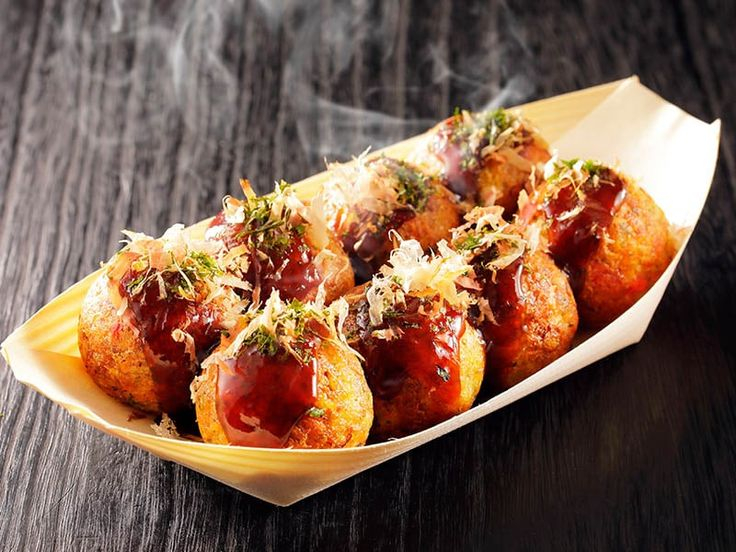
Screenshot of https://www.pinterest.com/pin/492299803037979291/ Video by Aden Films -
Senbei is a type of Japanese rice cake. It is a dry cake, made from rice flour or wheat flour, then baked in the oven or on a charcoal stove. Available in many shapes, sizes, and flavors, they are delicious but typically have the sweet flavor of rice. Senbei is often eaten with green tea as a simple dish for guests to see as a polite way to quench their thirst. Senbei is the common name for traditional Japanese dry cakes.
Senbei cakes of this period were quite simple, made only from flour and sugar. During the Edo period or Tokugawa period, Senbei had many innovations in processing methods. Many types of Senbei cakes appear with more flavors and different shapes. From there, two types of Senbei made from wheat flour and Senbei made from rice flour were formed.
- Senbei made from wheat flour: This is the traditional Senbei of the Kansai region. It is made from flour, sugar, and eggs, and tastes similar to cookies.
- Senbei made from rice: This type of Senbei is produced mainly in the Kanto region - the main rice production area of Japan. Most of this type of Senbei has a slightly salty taste. Senbei rice is usually prepared by mixing rice flour with warm water. The dough will be kneaded thoroughly and steamed immediately afterward. After steaming, the dough is kneaded again and then rolled into large rolls.
Senbei's shape is quite simple but very familiar to human life. Perhaps it is this characteristic that makes Senbei attractive to everyone. Nowadays, Senbei cake has been greatly improved in both processing method and form. Many modern ingredients are included in the Senbei recipe: cheese, chocolate, eggs, butter... making Senbei even richer in flavor while still retaining its traditional features.
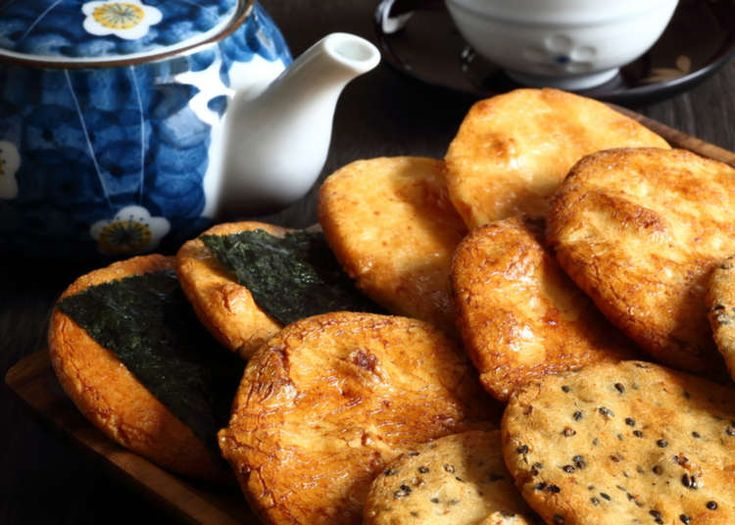
Screenshot of https://www.pinterest.com/pin/743234744777085391/ Video by Foody Cute -
Mitarashi Dango is a delectable Japanese street food that's bound to tantalize your taste buds. This traditional treat consists of skewered rice dumplings brushed with a sweet and savory soy glaze. You can find it in bustling food stalls and Japanese street food festivals.
With a perfect balance of flavors, Mitarashi Dango is on the list of the most popular Japanese street foods. The soft and chewy texture of the dumplings pairs harmoniously with the rich and sticky Mitarashi sauce. This sauce, made from soy sauce, sugar, and a hint of mirin, imparts a luscious glaze that adds depth and character to each bite. As you take your first nibble, the sweetness instantly dances on your palate, followed by the subtle notes that linger pleasantly.
One of the pleasures of indulging in Mitarashi Dango is watching it being prepared right before your eyes. Skewers of freshly grilled dango are meticulously glazed with tantalizing sauce, imparting an appetizing shine. Served warm, this morsel is perfect for savoring on a chilly day or enjoying as a midday snack during your exploration of Japan's vibrant streets.
Recipe for Mitarashi Dango:
- Put 100g rice flour, 100g glutinous rice flour, and 7 teaspoons of sugar in a large bowl, and mix well. Slowly sprinkle 150ml of warm water, and knead well until the dough is smooth. Divide the dough into small round balls like dumplings.
- Boil a pot of water. When the water boils, put the dough balls in and boil them like dumplings. When the dough floats, take it out and immediately put it in a bowl of cold water.
- Skewer the cake onto a bamboo stick, 1 skewer will have about 4-5 pieces of cake. Place the cake on the grill and grill evenly on all sides for about 4 minutes.
- Boil the mixture of soy sauce, sugar, mirin, and water. Mix cornstarch with water to get a smooth, slightly viscous mixture. After the soy sauce boils, pour cornstarch into the pot and stir until the sauce is slightly thick and thickens, then turn off the heat.
- Place the cake on a plate spread the sauce on top of the cake and enjoy.
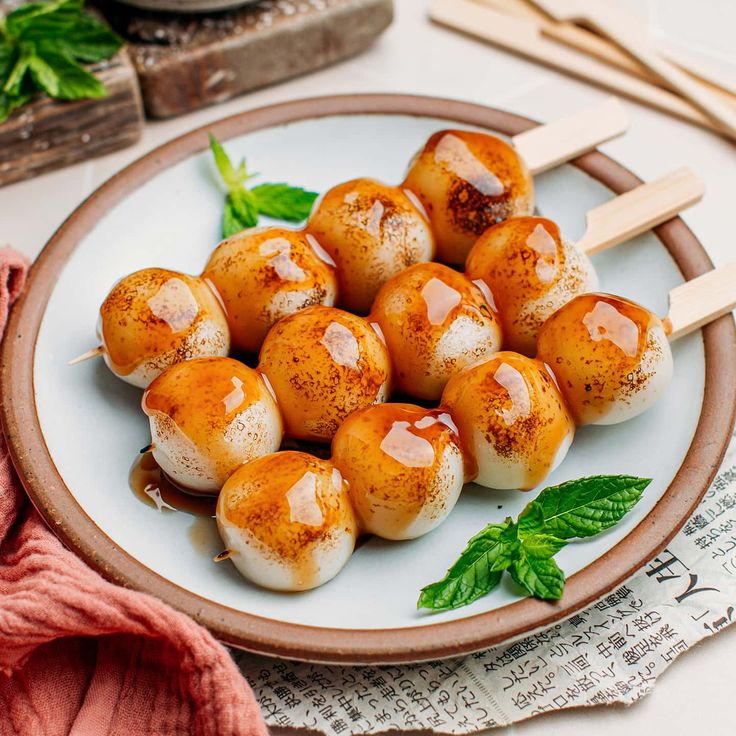
Screenshot of https://www.pinterest.com/pin/230387337181918793/ Video by https://www.youtube.com/watch?v=1KWlBHrfbW0 -
The "land of cherry blossoms" is famed for its street food Ikayaki because of its cheap price and convenience. Especially when the weather gets cold, enjoying a skewer of hot, fragrant squid will definitely be an effective way to dispel the cold weather.
The term “Ikayaki” refers to grilled squid dipped in soy sauce, so of course, the main ingredient of this dish is squid. Japanese people can use different types of ink with different sizes for processing. Usually, people will choose squid that is large in size and has thick but not tough meat. At the same time, it has a crispy, sweet taste that stimulates the taste buds.
Depending on each eatery, people can serve squid cut into small rings or whole pieces skewered. The squid's tentacles can be left alone or left alone, and sometimes they are even placed right in the center of the Ikayaki plate to highlight them. The cooked squid pieces will be eaten with soy sauce. Diners should also squeeze lemon on hot squid and can enjoy them with beer. This will add rich flavor to the dish.
There are two ways to make Ikayaki:
- Grilled on the grill: The squid pieces will be grilled on the grill for about 12-15 minutes. Be careful to turn the grill to avoid burning the squid and marinate so that the spices are absorbed evenly. Depending on the size of the squid, the baking time will be shorter or longer.
- Cook in a pan: Heat a pan with oil over medium heat. Put the squid in the pan for about 4-5 minutes and then turn it over occasionally. Then add the sauce and cook for another 1-2 minutes until the sauce has a thick consistency.
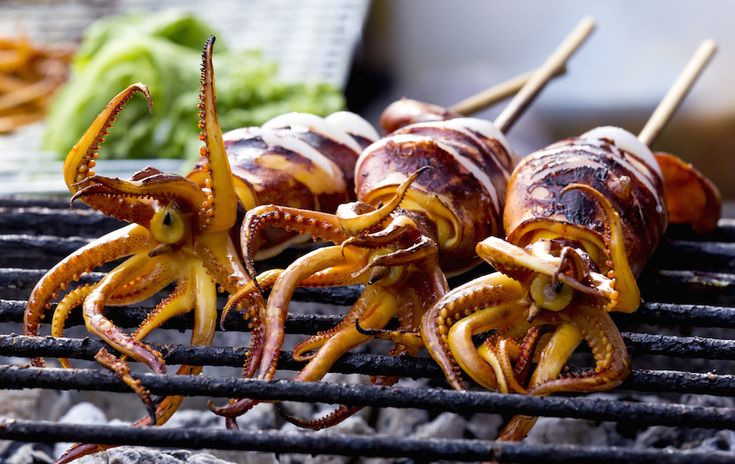
Screenshot of https://www.pinterest.com/pin/413064597055777471/ Video by Silver View -
Menchi Katsu is a Japanese-style piece of breaded and deep-fried meat. The meat can be beef, pork, or a mixture of both. It is often found in bento and teishoku. The crispy golden exterior gives way to a juicy and flavorful center, making it an irresistible treat for food enthusiasts.
Katsu is served with Japanese Worcestershire sauce or tonkatsu sauce and sliced cabbage. It can also be enjoyed with two soft buns for an enjoyable Menchi Katsu burger experience. Every bite is a perfect fusion of textures and tastes, combining the crispiness of the breading with the tenderness of the meat.
Menchi Katsu is a beloved street food that offers a quick and satisfying meal on the go. It has become a staple among locals looking for a tasty and affordable option, and a must-try for tourists seeking an authentic culinary experience in Japan.
Even better, you can easily make your own Menchi Katsu right at home, with common ingredients that are extremely easy to find in the supermarket.
- Cut 1 onion into small pieces, put it in the microwave, cover it with plastic wrap to prevent dehydration, then bake for 3 minutes.
- Put 300g of ground meat in a bowl with salt, sugar, nutmeg powder, and black pepper and mix well. Then add the breadcrumbs and continue to mix well, then finally add the beaten eggs.
- After roasting the onions, let them cool for a while, and then add them to the meat mixture. Continue to mix well and then put in the refrigerator to cool for about 5 minutes for easy shaping.
- Divide the meat mixture into 6 parts, shape into flat oval shapes.
- Soak in the following order: Flour -> Beaten eggs -> Breadcrumbs.
- Deep fry in oil at 170 degrees Celsius until the meat turns an attractive golden brown color (about 6 minutes).
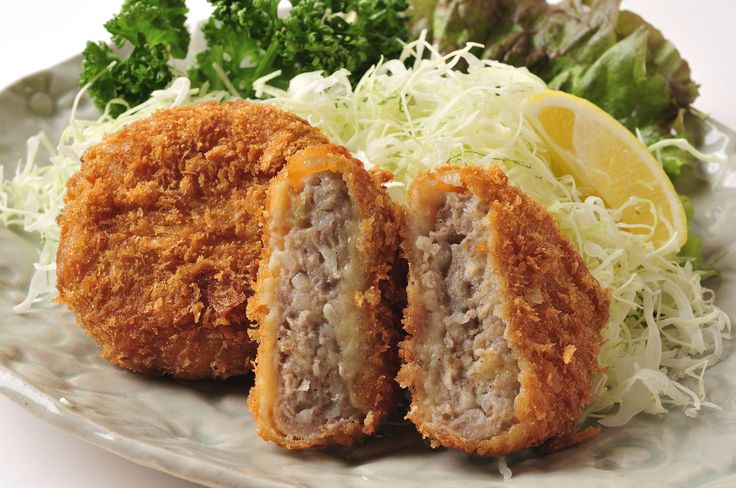
Screenshot of https://www.pinterest.com/pin/76420524916934153/ Video by Munchies -
Okonomiyaki is known as "Japanese pizza". It is one of the most popular Japanese street foods. Okonomiyaki is a dish that uses flour mixed with seafood and vegetables in water, then grilled on a Teppan grill, then dipped in sauce to eat. There are two types of Okonomiyaki famous in two different regions: Kansai Okonomiyaki and Hiroshima Okonomiyaki.
- Kansai Okonomiyaki: a type of pancake made by mixing flour with ingredients and then baking.
- Hiroshima Okonomiyaki: a type of cake that is placed on the grill without mixing the dough with the ingredients.
Okonomiyaki's batter is made with flour, eggs, dashi (a Japanese cooking stock), and shredded cabbage. From there, you can customize your Okonomiyaki with an array of toppings and fillings. Popular options include thinly sliced pork belly, shrimp, squid, cheese, and vegetables.
Once your Okonomiyaki is assembled on the hot griddle, it's time to watch it sizzle and bubble. The aroma alone will make your mouth water. Once cooked to perfection, it is generously slathered with Okonomiyaki sauce, which is similar to Worcestershire sauce but with a sweeter and tangier flavor. Finally, it's topped with a drizzle of mayonnaise, a sprinkle of bonito flakes, and a dusting of seaweed powder.
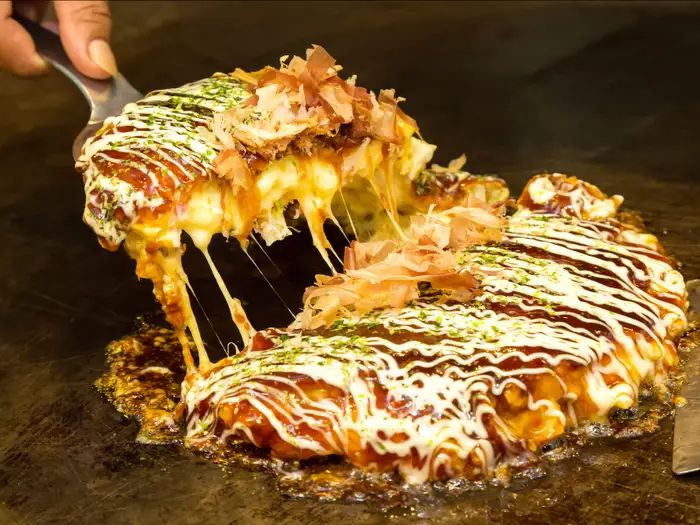
Screenshot of https://www.pinterest.com/pin/203154633180599829/ Video by Aden Films -
Karaage is a delicious street food in Japan. It is a popular dish that has gained recognition both locally and internationally. Known for its mouthwatering aroma and perfect balance of flavors, it has become an iconic dish of Japanese cuisine.
Traditionally, Karaage is made by marinating bite-sized pieces of chicken in a mixture of soy sauce, ginger, garlic, and other seasonings. The chicken is then lightly coated with potato starch or flour before being deep-fried to perfection. This process is different from the similar process of tempura. The result is a golden-brown and crispy exterior, while the meat remains tender and juicy on the inside.
Karaage can be enjoyed as a standalone dish accompanied by a variety of dipping sauces or as an ingredient in other dishes like bento boxes or ramen. Nowadays, you can even find karaage burgers or karaage tacos, showing how this street food has inspired new culinary creations.
Karaage is also widely available at festivals and food stalls across Japan. One such festival is Oita's annual Karaage Festival, where over 60 different shops participate to offer unique versions of Japanese delicacies. Karaage is a true testament to the creativity and flavors that Japan has to offer.
Steps to make Karaage fried chicken:
- Wash the chicken and cut it into bite-sized pieces, about 2-3cm in size.
- Marinate with spices including half a teaspoon of salt, 1 teaspoon of seasoning powder, and a little pepper, and leave in the refrigerator for about 30 minutes to infuse.
- After the meat has absorbed the spices, crack in 1 egg.
- Add tapioca starch and flour.
- Use chopsticks to stir the flour and eggs into the chicken.
- Add cooking oil to the pan, wait for the oil to heat, add each piece of chicken, and fry until golden.
- Remove the chicken to a basket lined with oil-absorbent paper, then place on a plate and decorate it as desired.
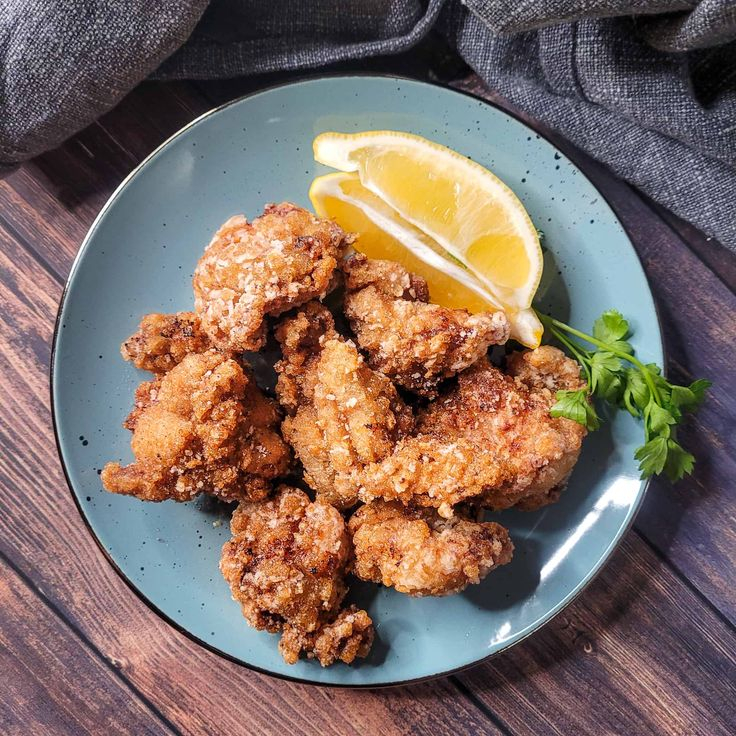
Screenshot of https://www.pinterest.com/pin/377317275046776924/ Video by yummy!! -Japanese Street Food- -
Kakigori is a traditional dish of the people of Japan and is a symbol of Japan in the summer. If you have traveled to Japan, you should not miss this delicious dish. This is a dish loved by all ages. Japanese shaved ice once appeared in the famous comic book Doraemon.
To create a delicious flavor for this dish, shops must use clean ice to cool naturally in a lake, not in a freezer. Then people will thin it and add a variety of ingredients on top, including syrup, condensed milk, or fruit. Kakigori has many flavors such as melon, peach, kiwi, strawberry, and Japanese citrus, or mix many flavors at the same time. Kakigori is extremely soft and melts on the tongue like freshly fallen snow.
Today, this traditional Japanese dish has been improved and many interesting variations have been introduced. Vendors in Japan are constantly exploring and creating interesting, delicious, and fun variations of Kakigori. They decorate the topping into funny shapes or Kakigori is covered with rum and set on fire.
Popular types of Kakigori shaved ice:
- Matcha Kakigori: This type of shaved ice with the main ingredients of sweet red beans, matcha, and condensed milk creates a traditional Japanese flavor, so many diners love this original flavor.
- Shirokuma Kakigori: A famous shaved ice dish in southern Japan with a layer of condensed milk along with fruit and jelly, and red bean powder mixed together extremely attractively. The top layer of shaved ice is sometimes made into a cute bear face shape because “Shiro Kuma” means “polar bear” in Japanese. In Japan, Shirokuma Kakigori is so popular that people can find commercial versions in convenience store freezers across Japan.
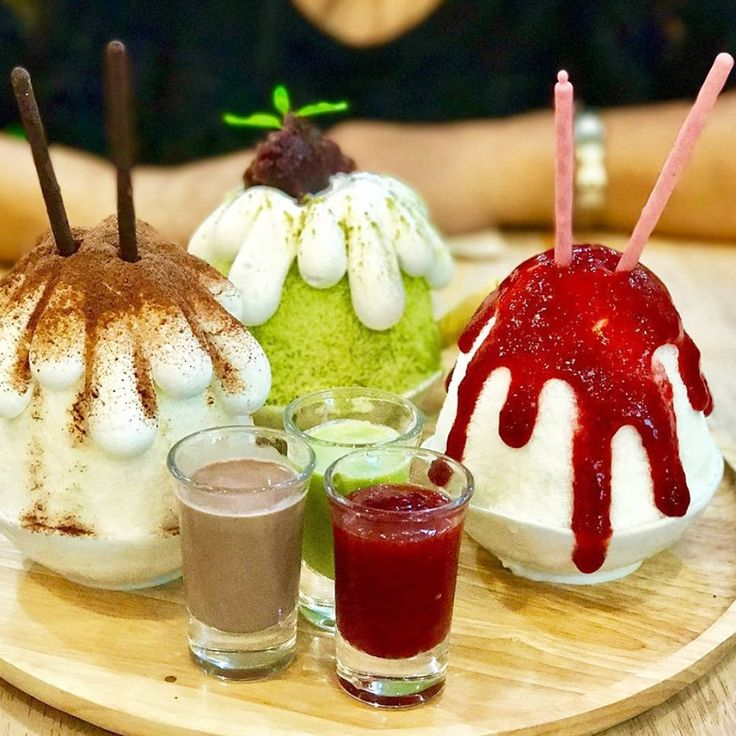
Screenshot of https://www.pinterest.com/pin/31666003621205853/ Video by Great Big Story -
The last name to appear on the list of the most popular Japanese street foods is Yakisoba. It is a stir-fried noodle dish with sauce, a Japanese dish but of Chinese origin, and is considered a variation of Chinese stir-fried vermicelli. Yakisoba first appeared in Japanese restaurants around the early 20th century.
Yakisoba has a unique flavor with a thick sweet sauce similar to oyster sauce. In Japanese, Yaki means stir-fry and Soba means noodles. It is a delicious, easy-to-make, and unique dish that Japanese people love and eat every day. Yakisoba is made by stir-frying wheat noodles with a variety of ingredients, such as thinly sliced pork, crunchy cabbage, onions, carrots, and bean sprouts. The noodles are cooked to perfection, achieving a slightly chewy texture, while the vegetables bring a refreshing crunch to the dish.
The sight of skilled chefs flipping the noodles on large iron griddles, skillfully tossing them with precision, is truly a sight to behold. Yakisoba is not only a nutritious dish but also a sensory experience, as the sizzling and aromatic fragrance creates an irresistible allure. Yakisoba is commonly found at food stalls, festivals, and outdoor events throughout Japan. Yakisoba shops are always crowded with customers waiting to buy and take away. A serving of noodles is packaged in a box so you can take the subway and eat breakfast at the same time.
How to make Japanese fried noodles Yakisoba:
- Soak the noodles in water until soft and then boil.
- Pour oil into the pan, when the oil is hot enough, add onions, peppers, and carrots and stir well for 2 minutes.
- Add cabbage and stir-fry for 2-3 minutes then remove from heat.
- add oil to the pan to stir-fry the chicken until cooked, then add noodles and vegetables.
- Season to taste with soy sauce and Yakisoba are ready
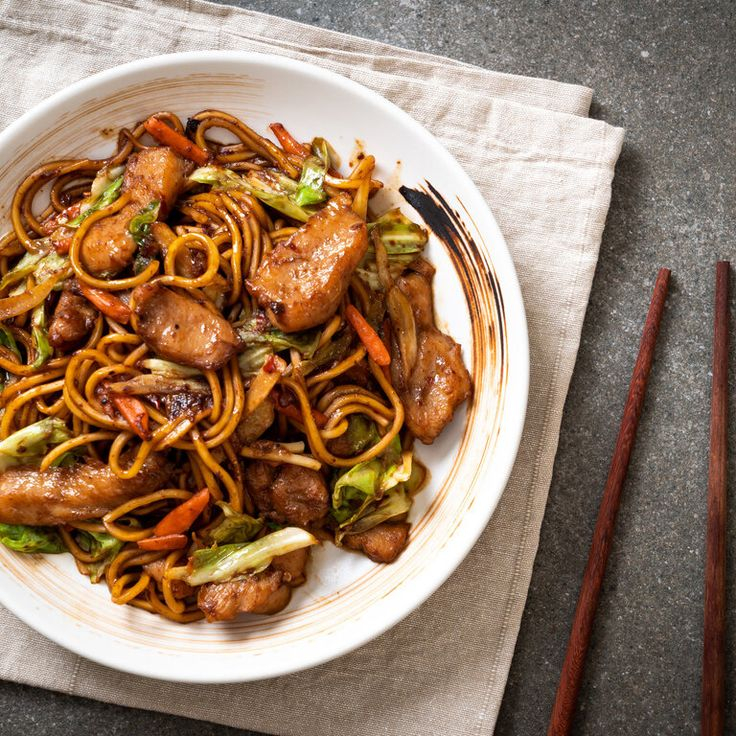
Screenshot of https://www.pinterest.com/pin/983755112338875411/ Video by The Chopstix












